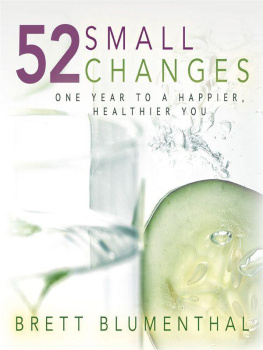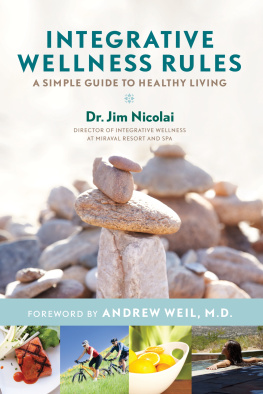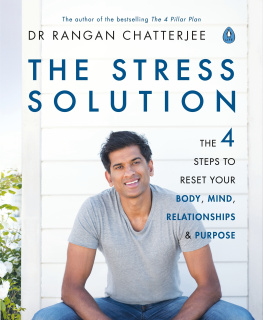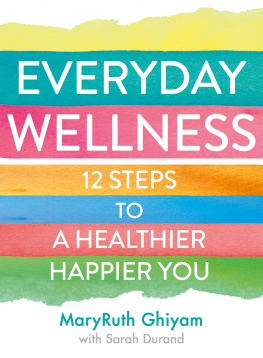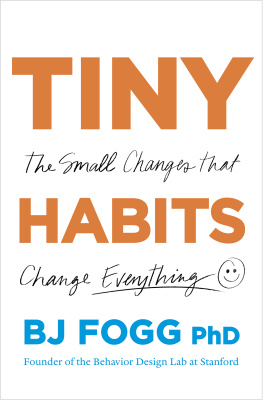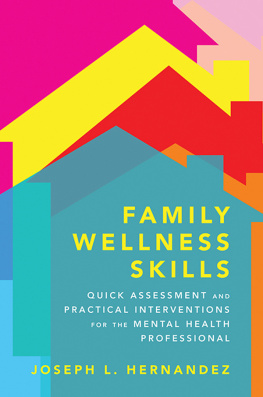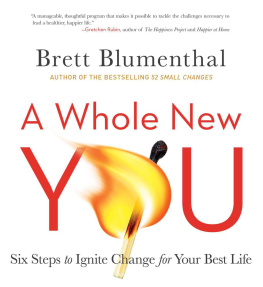BRETT BLUMENTHAL

Copyright 2011 by Brett Blumenthal. All rights reserved. No part of this publication may be reproduced, stored in a retrieval system, or transmitted, in any form or by any means, electronic, mechanical, photocopying, recording, or otherwise, without the written prior permission of the author. For information, write to info@sheerbalance.com .
ISBN: 978-1-61218-139-4
The information contained in this book is intended to provide helpful and informative material on the subject addressed. It is not intended to serve as a replacement for professional medical advice. Any use of the information in this book is at the readers discretion. The author and publisher specifically disclaim any and all liability arising directly or indirectly from the use or application of any information contained in this book. A health-care professional should be consulted regarding your specific situation.
Photography Agent: www.dreamstime.com ;
photography appearing are for Glenn Kulbako and the rest are dreamstime.
For David,
for your love and support,
and continuous belief in me.
Contents
Introduction
When it comes to creating change in our lives, even positive change, it can be really difficult: the older we get, the more difficult habits are to break; the more we have done something one way, the more difficult it is to do it another way; and the longer we have a perspective, the harder it is to change the way we see things. This is human nature. Yet its also human nature for us to assume that making a change will be easy and can be accomplished within a very short period of time.
Many of us yearn for instant gratification, and when something takes too long, we give up or move on. Unfortunately, the instant gratification we crave is the exact thing that hinders us from achieving success in our quest for change. The secret to making change that lasts is to acknowledge and accept that change takes time and that patience during the process is essential.
How Long Does Change Really Take?
You may have heard that it takes 18 days to make a change. Or maybe youve heard 21 or 28 days. In reality, the amount of time required to make lasting change is highly individualistic and depends on the person, the change, and the circumstances.
University College London psychologist Phillippa Lally conducted a study that looked at this very subject. She found that individuals who were trying to learn new habits, such as eating fruit on a daily basis, took an average of 66 days before the behavior had become automatic. In other words, it took subjects an average of 9 weeks to make lasting and permanent change. The range, however, included everything from a short 18 days to make change to a grueling 245 days. Although this may sound discouraging, I bring this up simply to highlight my point: change takes time.
As you embark on your journey to live a happier, healthier lifestyle, remember the following:
- One Big Change Takes Many Small Changes: There isnt any big change that doesnt require many smaller changes. Think about it: if your big change is to eat healthy, you probably need to do a variety of things to establish healthier eating habits. You might need to 1) cut out fried foods, 2) reduce portion sizes, 3) eat more vegetables, and so on.
- Extremes Dont Work: When we attempt to make major change in our lives, it is natural for us to want to go from all to nothingor vice versa. Lets take Bob, for instance. Bob never really exercised in the past, but wanted to get into shape. To do so, he decided to exercise for an hour every day of the week. Within a few weeks, Bob burned out, lost his motivation, and stopped exercising. He took on too much, too quickly. On the other hand, if Bob had eased into a fitness regimen by starting with two half-hour workouts per week, and then slowly added workout days and workout time over a few months, he wouldve had a better chance of sticking with the program and of the change lasting. Easing into change helps make it seem less overwhelming and more manageable.
- Small Changes Feed Our Need to Succeed: If we set out to make a big change but ignore each small step we take along the way, we never have a sense of accomplishment. If we make small changes and acknowledge our success in mastering each one, however, we feel as though we are making progress. This in turn inspires and motivates us to forge ahead with small change after small change, ultimately helping us to master the big change in the end.
Over the next 52 weeks, remind yourself of these important things so you can maintain a realistic view of the process and be most successful in your quest for a happy, healthy life.
Chapter 1
The 52 Small Changes Program
The 52 Small Changes Program is designed to encourage small yet meaningful changes that will ultimately lead to the big change of living a happier, healthier lifestyle. The idea is simple: make one small change per week for 52 weeks, and at the end of the year, youll be happier and healthier. This book is designed with two things in mind:
1) Although there are countless changes you can make, the 52 changes presented in this book are those that will have the largest impact on creating a happier, healthier lifestyle.
2) Giving yourself a year to create this lifestyle affords you the ability to slowly integrate important changes over time, so they are more likely to stick for the long-term.
Each of the 52 weekly changes outlined comes with an explanation as to why the change is important, as well as a Roadmap for Success, which provides you with tips and recommendations to help you successfully implement the change. By the end of each week, youll have worked to master the small change, or at least will have become proficient at it so that it is integrated into your lifestyle. Each week that follows, youll move onto a new change, while still incorporating the changes from previous weeks. By the end of a year, youll have mastered 52 changes thatll ultimately result in a happier, healthier you. Although these small changes will take some work, focusing on one per week will help to make them more manageable, and more importantly, more permanent.
For some of the changes, Ive also provided an Extra Credit section. The tips and recommendations under Extra Credit will help you take those changes you may already be incorporating into your lifestyle to a higher level of proficiency. If the change is new to you, however, focus on the tips provided under Roadmap for Success . If over time you become highly proficient at the change, then go back and try the Extra Credit .
Finally, to support you over the next 52 weeks, Ive provided Tools and Resources in Part III. Here youll find helpful trackers, templates, and other tools to support you through the process. I highly recommend you use these to keep you motivated and help you stay on track during the program.
A Holistic Approach
A happy, healthy lifestyle requires more than eating a healthy diet or being active. It requires that you address several aspects of life. To illustrate, lets take a look at Diane. A few years ago, Diane was suffering from tension headaches and migraines, and frequently resorted to a dark bedroom to alleviate the pain. Her immune system was weak, causing her to frequently get colds and sinus infections. And she felt sluggish or too tired to engage in any kind of activity. She was desperate for a solution.

